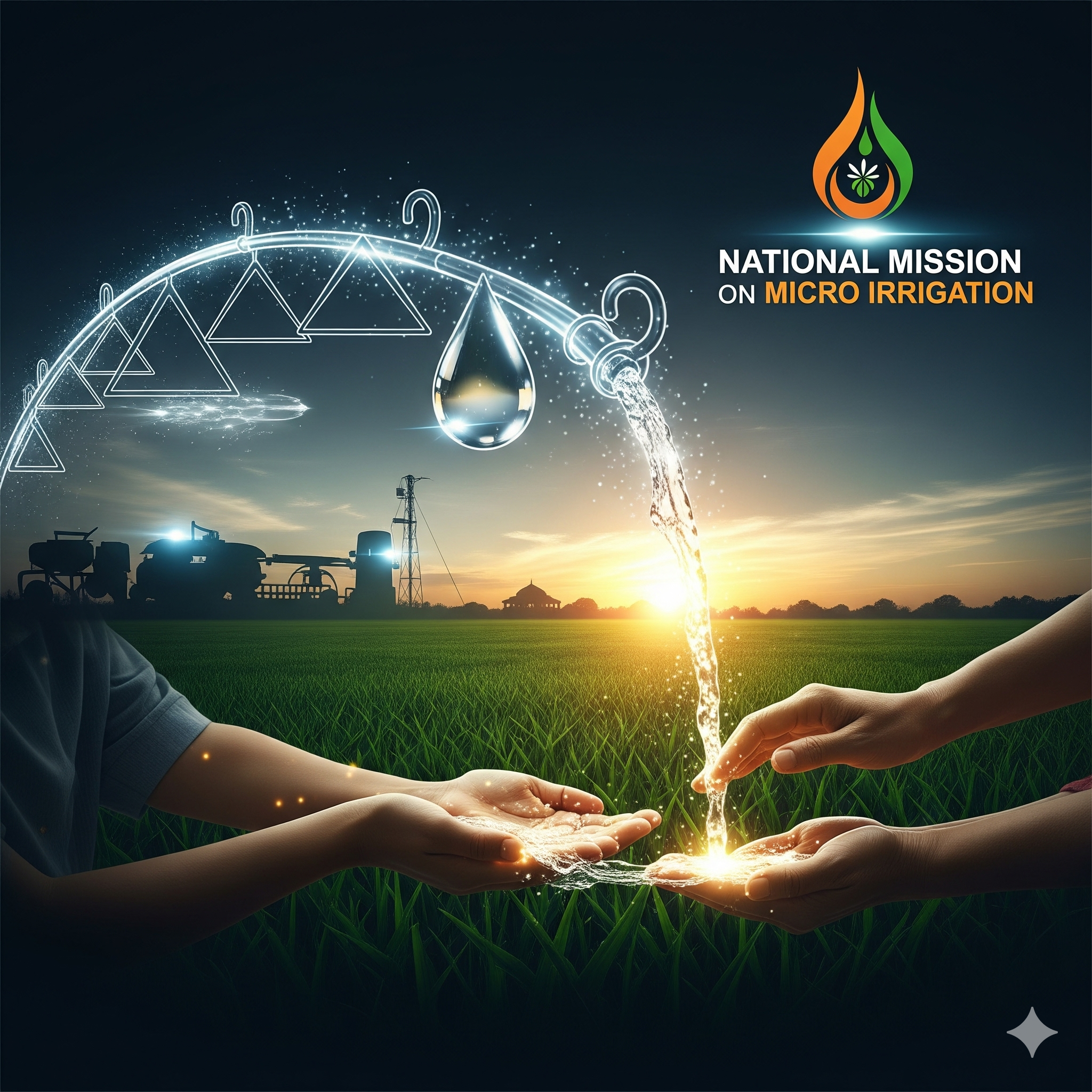Introduction
Water is one of the most critical resources for agriculture, and India, being heavily dependent on monsoon rainfall, faces significant challenges in efficient water management. A large proportion of India’s cultivated land suffers from water scarcity, over-extraction of groundwater, and inefficient irrigation practices. To address these issues, the Government of India launched the National Mission on Micro Irrigation (NMMI), a key component of the National Mission on Sustainable Agriculture (NMSA) under the National Action Plan on Climate Change (NAPCC).
The mission promotes efficient water use, precision irrigation techniques, improved crop productivity, and sustainable agricultural practices, ensuring better resource utilization, enhanced farmer income, and climate resilience.
Background and Need
- Agriculture and Water Dependency in India
- Agriculture accounts for around 80% of total freshwater consumption in India.
- Less than 50% of cultivated land is irrigated, while a majority of crops rely on rainfed or semi-irrigated conditions.
- Traditional irrigation methods like flood irrigation lead to water wastage, soil degradation, and lower productivity.
- Agriculture accounts for around 80% of total freshwater consumption in India.
- Water Scarcity and Climate Change
- Erratic rainfall, recurrent droughts, and depleting groundwater levels threaten food security and rural livelihoods.
- There is a pressing need for efficient water management techniques to sustain agriculture in water-stressed regions.
- Erratic rainfall, recurrent droughts, and depleting groundwater levels threaten food security and rural livelihoods.
- Genesis of National Mission on Micro Irrigation (NMMI)
- Launched in 2010–11 under the NMSA framework, NMMI aims to promote micro irrigation technologies such as drip and sprinkler systems.
- The programme seeks to increase water use efficiency, reduce water wastage, and enhance crop productivity.
- NMMI integrates technical, financial, and capacity-building interventions to encourage adoption among farmers.
- Launched in 2010–11 under the NMSA framework, NMMI aims to promote micro irrigation technologies such as drip and sprinkler systems.
Objectives of the National Mission on Micro Irrigation
The NMMI is designed with multiple objectives to achieve sustainable, water-efficient, and productive agriculture:
- Efficient Water Use
- Promote drip irrigation, sprinkler irrigation, and other micro irrigation systems.
- Reduce water wastage and increase water use efficiency by 30–50%.
- Enhanced Agricultural Productivity
- Ensure better crop growth, higher yields, and improved quality of produce through precise water application.
- Ensure better crop growth, higher yields, and improved quality of produce through precise water application.
- Expansion of Irrigated Area
- Extend irrigation to water-scarce regions and rainfed areas, making them productive.
- Extend irrigation to water-scarce regions and rainfed areas, making them productive.
- Promotion of Climate-Resilient Agriculture
- Reduce dependence on rainfall and mitigate effects of drought and erratic rainfall.
- Reduce dependence on rainfall and mitigate effects of drought and erratic rainfall.
- Resource Conservation
- Conserve soil, nutrients, energy, and fertilizers through efficient water management.
- Conserve soil, nutrients, energy, and fertilizers through efficient water management.
- Capacity Building and Technology Adoption
- Train farmers, technical personnel, and stakeholders on modern irrigation techniques, system maintenance, and best practices.
- Train farmers, technical personnel, and stakeholders on modern irrigation techniques, system maintenance, and best practices.
- Income and Livelihood Enhancement
- Increase farmers’ income by improving crop productivity, reducing input costs, and enabling multiple cropping cycles.
Key Features of NMMI
- Centrally Sponsored and State-Implemented Programme
- NMMI is a centrally sponsored scheme with funding shared between the Centre and states.
- States implement the mission through State Departments of Agriculture, Horticulture, and Watershed Development Agencies.
- NMMI is a centrally sponsored scheme with funding shared between the Centre and states.
- Focus on Micro Irrigation Technologies
- Drip irrigation: Delivers water directly to the plant root zone, minimizing wastage.
- Sprinkler irrigation: Provides uniform water distribution, suitable for horticulture, pulses, and cereals.
- Drip irrigation: Delivers water directly to the plant root zone, minimizing wastage.
- Financial Assistance for Farmers
- Subsidies and incentives are provided to small, marginal, and medium farmers for installing micro irrigation systems.
- Financial support reduces capital costs, encouraging adoption among resource-constrained farmers.
- Subsidies and incentives are provided to small, marginal, and medium farmers for installing micro irrigation systems.
- Integration with Other Schemes
- NMMI is linked with schemes such as:
- Pradhan Mantri Krishi Sinchai Yojana (PMKSY)
- National Horticulture Mission (NHM)
- Watershed Development Programmes
- NMMI is linked with schemes such as:
- Technology Promotion and Capacity Building
- Conducts demonstrations, workshops, and training programs for farmers and extension staff.
- Encourages adoption of modern irrigation scheduling, soil moisture sensors, and fertigation techniques.
- Conducts demonstrations, workshops, and training programs for farmers and extension staff.
- Focus on Sustainability
- Ensures efficient water use, reduced energy consumption, and long-term system maintenance.
- Promotes eco-friendly agriculture and reduced dependency on chemical inputs.
- Ensures efficient water use, reduced energy consumption, and long-term system maintenance.
Components of the National Mission on Micro Irrigation
The NMMI focuses on three key areas to achieve its objectives:
1. Micro Irrigation System Installation
- Drip Irrigation Systems:
- Deliver water directly to plant roots via pipes, drippers, and emitters.
- Ideal for fruit crops, vegetables, plantation crops, and horticulture.
- Sprinkler Irrigation Systems:
- Spray water uniformly over crops, mimicking rainfall.
- Suitable for cereals, pulses, and legumes.
- Hybrid Systems:
- Combination of drip and sprinkler for mixed cropping patterns.
2. Capacity Building and Training
- Training for farmers, technicians, and extension workers in:
- System installation, operation, and maintenance.
- Water scheduling, fertigation, and crop-specific irrigation requirements.
- Use of smart irrigation tools, sensors, and digital monitoring systems.
3. Research, Development, and Demonstration
- Promotion of R&D in water-saving technologies.
- Demonstration projects to showcase benefits of micro irrigation systems.
- Collaborations with ICAR, state agricultural universities, and private technology providers.
Implementation Mechanism
- Central-State Funding Pattern
- Funding is shared between Centre and States:
- General states: 50% central, 50% state
- North-Eastern and Himalayan states: 90% central, 10% state
- Funding is shared between Centre and States:
- Role of State Departments
- States identify eligible farmers, approve projects, and disburse subsidies.
- Monitor installation, system functionality, and farmer adoption.
- Subsidy and Financial Assistance
- Subsidy covers 30–80% of system cost, depending on farm size, crop, and category of farmer.
- Provides concessional loans through banks and financial institutions.
- Monitoring and Evaluation
- Use of Management Information Systems (MIS), geotagging, and online dashboards.
- Third-party evaluations assess adoption rate, water savings, yield improvements, and economic impact.
Benefits and Impact
- Water Use Efficiency
- Water savings of 30–50% compared to conventional irrigation.
- Reduces groundwater depletion and energy consumption.
- Enhanced Crop Productivity
- Targeted water delivery improves crop growth, quality, and yield.
- Enables multiple cropping cycles in a year.
- Farmer Income Enhancement
- Reduced input costs (water, fertilizers, energy).
- Higher yields and better quality produce result in improved market prices.
- Sustainability and Climate Resilience
- Micro irrigation reduces dependence on rainfall.
- Helps combat droughts, irregular monsoon, and climate-induced crop stress.
- Soil Fertility and Nutrient Management
- Enables fertigation, delivering nutrients along with water efficiently.
- Reduces fertilizer wastage and nutrient leaching, improving soil health.
- Energy Efficiency
- Reduced water pumping lowers electricity and diesel consumption.
Challenges in Implementation
- High Initial Costs
- Even with subsidies, installation costs can be a barrier for small farmers.
- Even with subsidies, installation costs can be a barrier for small farmers.
- Technical Knowledge Gap
- Farmers may lack expertise in system operation, maintenance, and fertigation.
- Farmers may lack expertise in system operation, maintenance, and fertigation.
- Maintenance and Sustainability
- Regular cleaning of drippers, pipes, and filters is essential to prevent clogging.
- Poor maintenance can reduce efficiency and system lifespan.
- Water Supply Constraints
- Micro irrigation requires reliable water availability, which may be limited in some regions.
- Micro irrigation requires reliable water availability, which may be limited in some regions.
- Awareness and Adoption
- Farmers need education and exposure to benefits to adopt micro irrigation widely.
Future Prospects
- Digital and Smart Irrigation
- Integration of IoT sensors, mobile apps, and precision irrigation scheduling.
- Real-time soil moisture monitoring and automated water delivery.
- Expansion to Rainfed Areas
- Promoting micro irrigation in semi-arid and rainfed regions to enhance productivity.
- Promoting micro irrigation in semi-arid and rainfed regions to enhance productivity.
- Integration with Climate-Smart Agriculture
- Linking micro irrigation with drought-resistant crops, soil moisture conservation, and agroforestry.
- Linking micro irrigation with drought-resistant crops, soil moisture conservation, and agroforestry.
- Private Sector and PPP Engagement
- Encourage private sector participation in technology supply, training, and maintenance.
- Encourage private sector participation in technology supply, training, and maintenance.
- Research and Innovation
- Promote low-cost, energy-efficient micro irrigation systems.
- Focus on crop-specific water-saving solutions and adaptive technologies.
- Farmer Income and Livelihood Enhancement
- Enable high-value crops, horticulture, and multiple cropping systems for sustained income growth.
Conclusion
The National Mission on Micro Irrigation (NMMI) is a pivotal initiative for sustainable water management, agricultural productivity, and climate resilience in India. By promoting efficient irrigation technologies, capacity building, and integrated approaches, the mission ensures that farmers can maximize yields, reduce input costs, and secure livelihoods.
Despite challenges such as high initial costs, maintenance issues, and water supply limitations, NMMI’s focus on technology adoption, financial support, and awareness creation positions it as a key strategy for transforming India’s agricultural landscape.
Through the expansion of micro irrigation, integration with climate-smart practices, and innovative solutions, NMMI contributes to food security, resource conservation, and sustainable rural development, making it a cornerstone of India’s agricultural and water management policies.




